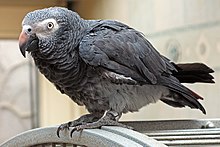Timneh parrot
| Timneh parrot | |
|---|---|
 |
|
| In captivity | |
| Scientific classification | |
| Kingdom: | Animalia |
| Phylum: | Chordata |
| Class: | Aves |
| Order: | Psittaciformes |
| Superfamily: | Psittacoidea |
| Family: | Psittacidae |
| Subfamily: | Psittacinae |
| Genus: | Psittacus |
| Species: | P. timneh |
| Binomial name | |
|
Psittacus timneh Fraser, 1844 |
|
| Synonyms | |
|
|
The Timneh parrot (Psittacus timneh), also known as the Timneh grey parrot or Timneh African grey parrot, is a West African parrot that is variously considered a subspecies of the African grey parrot Psittacus erithacus timneh, or a full species Psittacus timneh. In aviculture, it is often referred to by the initials TAG and is commonly kept as a companion parrot.
Growing to 28–33 centimetres (11–13 in) in length and weighing 275–375 grams (9.7–13.2 oz), the Timneh is a medium-sized parrot. Its plumage is mainly a mottled grey, with a white face mask and pale yellow eyes. Compared with the only other recognised Psittacus species, often known as the African grey parrot or Congo African grey parrot (Psittacus erithacus), the Timneh is smaller and darker, with a dull, dark maroon (rather than crimson) tail and a horn-coloured patch on the upper mandible. As in the nominate species, the Timneh parrot is also a very intelligent bird and a skilled mimic. The Timneh parrot may be less nervous and more outgoing around human beings, and can learn to talk at a younger age than the Congo grey.
The Timneh parrot is endemic to the western parts of the moist Upper Guinean forests and bordering savannas of West Africa from Guinea-Bissau, Sierra Leone and southern Mali eastwards to at least 70 km east of the Bandama River in Ivory Coast. There is no natural range overlap with the Congo parrot although, as both taxa are common in aviculture, escapes can occur and hybridization between Congo and Timneh greys has been observed in captivity. The birds typically inhabit dense forest, but are also seen at forest edges and in clearings, in gallery forest along waterways, savanna woodland and mangroves. Though they are sometimes found in cultivated areas and gardens, it is not clear whether these habitats contain self-sustaining populations; the birds may make seasonal movements out of the driest parts of their range in the dry season.
...
Wikipedia

